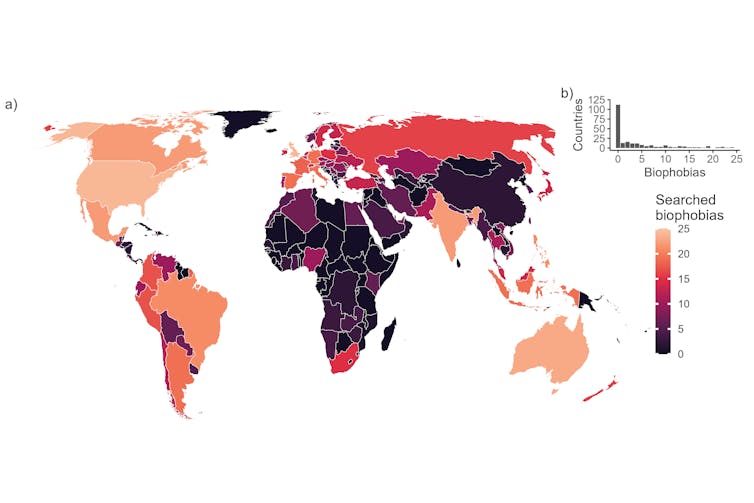“I can’t even watch a snake on TV without feeling sick to my stomach.”
“Swimming? Forget about it… I’m too afraid of sharks!”
“I can’t even be in the same room as a spider, it freaks me out.”
Fear, disgust, and other phobic reactions are not uncommon when it comes to our interactions with the natural world – who doesn’t know someone who is afraid of spiders or snakes? Indeed, fear of spiders (arachnophobia) or of snakes (ophidiophobia) are thought to be among the most common “biophobias”.
The latter is defined by the American Psychological Association as “the fear toward certain species and general aversion to nature that creates an urge to affiliate with technology and other human artifacts, interests, and constructions rather than with animals, landscapes, and other elements of the natural world”.
There are evolutionary reasons for this behaviour: in our ancestral past, nature was a potential source of danger, and phobic reactions toward certain elements of the living world may have helped early humans to avoid infectious diseases or harmful encounters with dangerous organisms.
Drivers of contemporary fear of nature
But what about nowadays? It is estimated that more than half of the world’s population lives in urbanised areas far removed from wildlife, and so we might expect a reduction in the prevalence of such fears. However, people continue to exhibit strong phobic responses toward organisms that do not live in our immediate vicinity even if they pose no tangible threats. This is worrying because it can lead to excessive anxiety and avoidance of interactions with nature, preventing affected individuals from experiencing the many physical and mental benefits that nature can provide.
Researchers interested in this phenomenon have therefore started to explore the reasons behind the sustained prevalence of nature phobias in modern societies. One hypothesis that has been put forward for this phenomenon points toward living in urbanised areas as a key driver of fear of nature in contemporary societies. The same conditions that protect us from potentially hazardous natural encounters also imply reduced opportunities to interact with nature. The absence of regular nature experiences, and the contextual information they provide, may cause people to wrongly evaluate the potential dangers associated with nature and lead to unfounded fears or disgust. Contemporary societies may suffer from a vicious cycle of biophobia, whereby nature disconnection leads to nature phobias and vice versa.
In this context, some researchers have suggested that biophobias may be increasingly prevalent across in modern societies but the extent to which this is true remains difficult to assess. Data on the prevalence of nature phobias is scarce, and is usually collected at specific points in time through targeted surveys, posing a challenge to assess how it has changed over time.
In a recent study, we approached this question through a different angle, using the power of the Internet. We reasoned that people suffering from nature-related phobias may search for online information about their condition and how to cope with it. Using worldwide data from Internet searches, we assessed the relative volume of Internet searches for 25 common biophobias between 2004 and 2022.
How prevalent are biophobias nowadays?
Our study suggests the most common biophobias include fear of spiders, microbes and germs (mysophobia), and parasites (parasitophobia). These results corroborate other reports that fear of spiders is among the most common nature-related phobias.
We also found a steady increase in online search volume for biophobias between 2004 and 2022, albeit with marked differences in trends for specific phobias. Interest in the some of the most common biophobias, such as fear of snakes (ophidiophobia) or germs, is also increasing, which suggests they are becoming more prevalent. For instance, our results show that searches for fear of germs peaked around the onset of the Covid-19 pandemic, providing additional evidence of the psychological strains caused by the pandemic. In contrast, only a few biophobias showed negative or stable trends. These trends were calculated based on the proportion of searches for biophobias in relation to the total number searches over the years, and thus cannot be simply explained by increasing Internet use.
Additionally, we found evidence that at the country level, interest in a larger number of nature-related phobias related to the percentage of the population living in urbanised environments, the population’s trend (whether it is growing or stable) and the number of venomous species found in the country. Specifically, interest in more nature-related phobias is concentrated in countries with large, stable and long-established urban populations such as Australia, Canada, Germany, the United States, or the United Kingdom. It is possible that a disconnection with nature has had more time to crystallise in these countries where some people have only experienced urban living during their lifetime. In contrast, many countries with smaller but rapidly growing urban populations, such as many countries in Africa and the Middle East, expressed less online interest in nature-related phobias.

Other possible explanations for our results include aspects related to differences in Internet access between countries or the motivations behind Internet searches for biophobias. For example, populations in urban areas also tend to have better Internet access and this could explain the lower prevalence of searches for biophobias in rural areas. It could also be that fear toward nature may be seen as a useful response in more rural areas and thus not something that people would search for ways to cope with. We are also aware that search engines other than Google dominate the market in countries such as China and Russia, which could also affect our results.
Nevertheless, our findings support the idea that disconnection from nature is growing in many modern societies due to urban living and is having an increasing cost on human well-being by promoting unfounded fears toward other life forms. As human societies become more urbanised, we risk losing our connection to the natural world, and developing more negative perceptions of and interactions with nature. It is time to reevaluate our relationship with nature and develop ways to bridge the gap, rather than widen it. The future of our well-being may very well depend on it.



